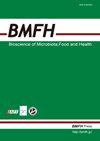肠道微生物组分析验证小鼠糙皮病模型
IF 2.9
4区 医学
Q2 Agricultural and Biological Sciences
引用次数: 4
摘要
糙皮病是由于异常的摄入量和/或烟酸的使用,但其表型是多样化的。糙皮病的表型也可以是非典型的,如恶心。我们之前报道了一个小鼠皮糙皮相关恶心模型。然而,该模型的机制尚不清楚。在这项研究中,我们发现肠道微生物群,被认为是烟酸的来源,发挥了重要作用的发展在无菌鼠pellagra-related恶心。我们还研究了肠道微生物群。我们比较了正常饮食和低烟酸饮食小鼠的尿烟酸代谢物水平和皮肤反应,以研究糙皮病的可能诱因。低烟酸饮食小鼠的环氧二碳三烯酸和羟基二碳四烯酸水平高于正常饮食小鼠。此外,组织学研究表明,皮肤对低烟酸饮食有反应。有趣的是,较高的氧化脂肪酸的无菌状态也被观察到。这些发现表明我们通过肠道菌群成功建立了新建立的小鼠糙皮病模型。我们相信,这个模型可以使糙皮病的推定原因和糙皮病的表型尚未被认识到的发现。本文章由计算机程序翻译,如有差异,请以英文原文为准。
Analysis of the gut microbiome to validate a mouse model of pellagra
Pellagra is caused by an abnormal intake and/or use of niacin, but its phenotypes are diverse. The phenotypes of pellagra can also be atypical, such as nausea. We previously reported a mouse model of pellagra-related nausea. However, the mechanism of this model is unclear. In this study, we found that the gut microbiota, which is thought to be a source of niacin, played an important role in the development of pellagra-related nausea in germ-free mice. We also investigated the gut microbiome. We compared urinary niacin metabolite levels and the dermal response between mice fed a normal diet and those fed a low-niacin diet to investigate the putative trigger of pellagra. Epoxyeicosatrienoic and hydroxyeicosatetraenoic acid levels were higher in mice fed a low-niacin diet compared with those fed a normal diet. Furthermore, histological studies indicated a dermatological response to the low-niacin diet. Interestingly, higher levels of oxidised fatty acids in response to the germ-free state were also observed. These findings indicate successful establishment of our newly established mouse model of pellagra via the gut microbiota. We believe that this model could enable the discovery of the putative cause of pellagra and phenotypes of pellagra that have not been recognised yet.
求助全文
通过发布文献求助,成功后即可免费获取论文全文。
去求助
来源期刊

Bioscience of Microbiota, Food and Health
Immunology and Microbiology-Applied Microbiology and Biotechnology
CiteScore
5.50
自引率
3.20%
发文量
24
期刊介绍:
Bioscience of Microbiota, Food and Health (BMFH) is a peer-reviewed scientific journal with a specific area of focus: intestinal microbiota of human and animals, lactic acid bacteria (LAB) and food immunology and food function. BMFH contains Full papers, Notes, Reviews and Letters to the editor in all areas dealing with intestinal microbiota, LAB and food immunology and food function. BMFH takes a multidisciplinary approach and focuses on a broad spectrum of issues.
 求助内容:
求助内容: 应助结果提醒方式:
应助结果提醒方式:


